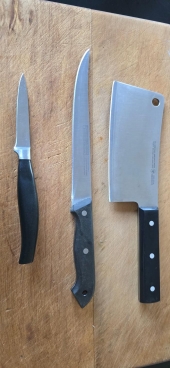


Sonja Draven wrote:Acadia, welcome!!
How would you suggest a brand new gardener get started if they're on a tight budget? When I lived in an apartment, I loved the idea of growing my own food but it seemed I made mistakes and ended up spending money with no food to show for it. I have more land now but still a tight budget...


Delia Reed wrote:Also understand this, having had raw cow milk and raw goat milk and raw sheep milk, cow milk is different from the others in that it naturally separates. It isn't fun to drink because it won't stay homogenized. It is really better for making butter. Most people have concern over taste. OK, know this, if you are using the Meyenburg store milk as an example of the terrible taste of goat milk, there are some factors that contribute to that awfulness-
1. the caprylic acid and perhaps other factors in their milk is very sensitive to pasturizaton and makes it bitter. Commercial goat butter is bitter and awful. it is ruined. If it sits too long, I can also get this flavor. But like the high brix produce, when the goats and sheep are fed high dense nutrients the milk shold be sweet and stay sweet for about 2 weeks.
2. wash your hands, wash your equipment, get stainless steel equipment without edges to hide bacteria, and don't get your fingers in the milk, don't touch the edge of the bucket that you pour from, the trick is cleanliness. There used to be a picture on the meyenburg website of a vat of milk and a staff member had her hand in it. Very, very bad.
3. Watch the dust. I keep a paper towel soaked in H2O2 over the bucket edge (it has a half moon lid) between squeezing and pouring, as dust is our worst enemy- i need to redesign my milk room to keep it out.
And watch the goat nutrition- we fed kelp free choice and were feeding rice bran until they found it was contaminated (yes human rice too, organic too) with arsenic. And we haven't yet found a comparable replacement, until we can get the pasture in shape.
If you look at the edge of the Meyenburb carton, it says "shake well" why does it say that? Hmmm? if you don't shake well, and pour it off carefully, there is a 1/4 inch layer of darker scum in the bottom. Cream rises and it is white. When i read the Milk Book by William Douglass MD, he mentioned pus in pasteurized dairy cow's milk. Perhaps, the cow milk people are better at pouring so their pus stays in the tank and not going into the cartons. If your animal is making a thin layer of pus in the bottom of the jar after it sits for a bit, I recommend a product from franklampley.com, called Vitamix. If you fed them this by the teaspoon (some will demand more- I let them have it- they seem to know best what they need). They vitamins in there lack D and E so know that, but it has very absorbable minerals that are aminoacid chelated, which is more concentrated than any human vitamin i have seen- Human vitamins are cut with fillers. And their magnesium is often an oxide, even one of my favorite green ones.
I have found bulk vitamin powdrs to add D and E online, there are a few companies that sell thes for very reasonable. In the winter and kidding time, these are pretty important. e is a lifesaver and makes the difference between a weak, floppy non nursing kid or lamb and a smart jumping around kid or lamb that found the teat on his own and will be completely taken care of by his own mama. There is also selenium in the trace mineral block as well as copper, and the kelp, we use both, we are deficient in everything here, even the sheep need copper.


